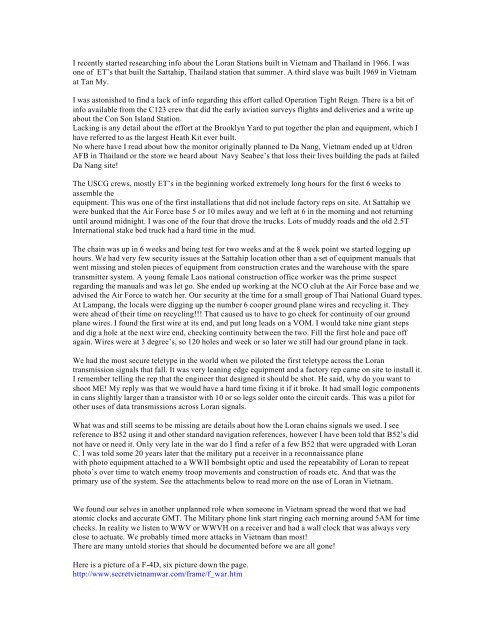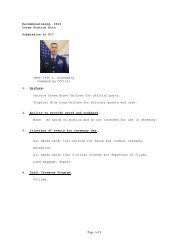The F-4D at the top of the - loran-history.info
The F-4D at the top of the - loran-history.info
The F-4D at the top of the - loran-history.info
Create successful ePaper yourself
Turn your PDF publications into a flip-book with our unique Google optimized e-Paper software.
I recently started researching <strong>info</strong> about <strong>the</strong> Loran St<strong>at</strong>ions built in Vietnam and Thailand in 1966. I was<br />
one <strong>of</strong> ET’s th<strong>at</strong> built <strong>the</strong> S<strong>at</strong>tahip, Thailand st<strong>at</strong>ion th<strong>at</strong> summer. A third slave was built 1969 in Vietnam<br />
<strong>at</strong> Tan My.<br />
I was astonished to find a lack <strong>of</strong> <strong>info</strong> regarding this effort called Oper<strong>at</strong>ion Tight Reign. <strong>The</strong>re is a bit <strong>of</strong><br />
<strong>info</strong> available from <strong>the</strong> C123 crew th<strong>at</strong> did <strong>the</strong> early avi<strong>at</strong>ion surveys flights and deliveries and a write up<br />
about <strong>the</strong> Con Son Island St<strong>at</strong>ion.<br />
Lacking is any detail about <strong>the</strong> effort <strong>at</strong> <strong>the</strong> Brooklyn Yard to put toge<strong>the</strong>r <strong>the</strong> plan and equipment, which I<br />
have referred to as <strong>the</strong> largest He<strong>at</strong>h Kit ever built.<br />
No where have I read about how <strong>the</strong> monitor originally planned to Da Nang, Vietnam ended up <strong>at</strong> Udron<br />
AFB in Thailand or <strong>the</strong> store we heard about Navy Seabee’s th<strong>at</strong> loss <strong>the</strong>ir lives building <strong>the</strong> pads <strong>at</strong> failed<br />
Da Nang site!<br />
<strong>The</strong> USCG crews, mostly ET’s in <strong>the</strong> beginning worked extremely long hours for <strong>the</strong> first 6 weeks to<br />
assemble <strong>the</strong><br />
equipment. This was one <strong>of</strong> <strong>the</strong> first install<strong>at</strong>ions th<strong>at</strong> did not include factory reps on site. At S<strong>at</strong>tahip we<br />
were bunked th<strong>at</strong> <strong>the</strong> Air Force base 5 or 10 miles away and we left <strong>at</strong> 6 in <strong>the</strong> morning and not returning<br />
until around midnight. I was one <strong>of</strong> <strong>the</strong> four th<strong>at</strong> drove <strong>the</strong> trucks. Lots <strong>of</strong> muddy roads and <strong>the</strong> old 2.5T<br />
Intern<strong>at</strong>ional stake bed truck had a hard time in <strong>the</strong> mud.<br />
<strong>The</strong> chain was up in 6 weeks and being test for two weeks and <strong>at</strong> <strong>the</strong> 8 week point we started logging up<br />
hours. We had very few security issues <strong>at</strong> <strong>the</strong> S<strong>at</strong>tahip loc<strong>at</strong>ion o<strong>the</strong>r than a set <strong>of</strong> equipment manuals th<strong>at</strong><br />
went missing and stolen pieces <strong>of</strong> equipment from construction cr<strong>at</strong>es and <strong>the</strong> warehouse with <strong>the</strong> spare<br />
transmitter system. A young female Laos n<strong>at</strong>ional construction <strong>of</strong>fice worker was <strong>the</strong> prime suspect<br />
regarding <strong>the</strong> manuals and was let go. She ended up working <strong>at</strong> <strong>the</strong> NCO club <strong>at</strong> <strong>the</strong> Air Force base and we<br />
advised <strong>the</strong> Air Force to w<strong>at</strong>ch her. Our security <strong>at</strong> <strong>the</strong> time for a small group <strong>of</strong> Thai N<strong>at</strong>ional Guard types.<br />
At Lampang, <strong>the</strong> locals were digging up <strong>the</strong> number 6 cooper ground plane wires and recycling it. <strong>The</strong>y<br />
were ahead <strong>of</strong> <strong>the</strong>ir time on recycling!!! Th<strong>at</strong> caused us to have to go check for continuity <strong>of</strong> our ground<br />
plane wires. I found <strong>the</strong> first wire <strong>at</strong> its end, and put long leads on a VOM. I would take nine giant steps<br />
and dig a hole <strong>at</strong> <strong>the</strong> next wire end, checking continuity between <strong>the</strong> two. Fill <strong>the</strong> first hole and pace <strong>of</strong>f<br />
again. Wires were <strong>at</strong> 3 degree’s, so 120 holes and week or so l<strong>at</strong>er we still had our ground plane in tack.<br />
We had <strong>the</strong> most secure teletype in <strong>the</strong> world when we piloted <strong>the</strong> first teletype across <strong>the</strong> Loran<br />
transmission signals th<strong>at</strong> fall. It was very leaning edge equipment and a factory rep came on site to install it.<br />
I remember telling <strong>the</strong> rep th<strong>at</strong> <strong>the</strong> engineer th<strong>at</strong> designed it should be shot. He said, why do you want to<br />
shoot ME! My reply was th<strong>at</strong> we would have a hard time fixing it if it broke. It had small logic components<br />
in cans slightly larger than a transistor with 10 or so legs solder onto <strong>the</strong> circuit cards. This was a pilot for<br />
o<strong>the</strong>r uses <strong>of</strong> d<strong>at</strong>a transmissions across Loran signals.<br />
Wh<strong>at</strong> was and still seems to be missing are details about how <strong>the</strong> Loran chains signals we used. I see<br />
reference to B52 using it and o<strong>the</strong>r standard navig<strong>at</strong>ion references, however I have been told th<strong>at</strong> B52’s did<br />
not have or need it. Only very l<strong>at</strong>e in <strong>the</strong> war do I find a refer <strong>of</strong> a few B52 th<strong>at</strong> were upgraded with Loran<br />
C. I was told some 20 years l<strong>at</strong>er th<strong>at</strong> <strong>the</strong> military put a receiver in a reconnaissance plane<br />
with photo equipment <strong>at</strong>tached to a WWII bombsight optic and used <strong>the</strong> repe<strong>at</strong>ability <strong>of</strong> Loran to repe<strong>at</strong><br />
photo’s over time to w<strong>at</strong>ch enemy troop movements and construction <strong>of</strong> roads etc. And th<strong>at</strong> was <strong>the</strong><br />
primary use <strong>of</strong> <strong>the</strong> system. See <strong>the</strong> <strong>at</strong>tachments below to read more on <strong>the</strong> use <strong>of</strong> Loran in Vietnam.<br />
We found our selves in ano<strong>the</strong>r unplanned role when someone in Vietnam spread <strong>the</strong> word th<strong>at</strong> we had<br />
<strong>at</strong>omic clocks and accur<strong>at</strong>e GMT. <strong>The</strong> Military phone link start ringing each morning around 5AM for time<br />
checks. In reality we listen to WWV or WWVH on a receiver and had a wall clock th<strong>at</strong> was always very<br />
close to actu<strong>at</strong>e. We probably timed more <strong>at</strong>tacks in Vietnam than most!<br />
<strong>The</strong>re are many untold stories th<strong>at</strong> should be documented before we are all gone!<br />
Here is a picture <strong>of</strong> a F-<strong>4D</strong>, six picture down <strong>the</strong> page.<br />
http://www.secretvietnamwar.com/frame/f_war.htm
<strong>The</strong> F-<strong>4D</strong> <strong>at</strong> <strong>the</strong> <strong>top</strong> <strong>of</strong> <strong>the</strong> picture, FA 788, is LORAN equipped (<strong>the</strong> towel rack on <strong>the</strong> back bone)<br />
and FG 815 is equipped with <strong>the</strong> laser design<strong>at</strong>or called "ZOTZ." <strong>The</strong> scope assy was mounted on<br />
<strong>the</strong> left canopy. <strong>The</strong> pilot would make <strong>the</strong> aiming limits on his canopy wi th a grease pencil as called<br />
out by <strong>the</strong> WSO. LORAN was <strong>the</strong> long range altern<strong>at</strong>ive to Comb<strong>at</strong> Skyspot which relied upon short<br />
range ground st<strong>at</strong>ions in Laos. <strong>The</strong>se photos are from about '71-'73.<br />
AN/ARN-92 LORAN-D equipment was fitted to Pave Phantom F-<strong>4D</strong>s. <strong>The</strong>y could be identified by a r<strong>at</strong>her<br />
prominent "towel-rail" antenna on <strong>the</strong> upper rear fuselage behind <strong>the</strong> rear cockpit. A total <strong>of</strong> 72 aircraft<br />
from blocks 32 and 33 were so equipped. In Vietnam, <strong>the</strong> primary mission <strong>of</strong> <strong>the</strong>se Pave Phantom F-<strong>4D</strong>s<br />
was <strong>the</strong> seeding <strong>of</strong> <strong>the</strong> Ho Chi Minh trail with sensors, which required <strong>the</strong> precise nighttime navig<strong>at</strong>ional<br />
capability provided by LORAN. <strong>The</strong> primary oper<strong>at</strong>ors <strong>of</strong> <strong>the</strong> "towel-rail" F-<strong>4D</strong>s were <strong>the</strong> 25th and 497th<br />
TFS <strong>of</strong> <strong>the</strong> 8th TFW and <strong>the</strong> 555th TFS <strong>of</strong> <strong>the</strong> 432nd TFW. Subsequently, <strong>the</strong>se planes were passed along<br />
to <strong>the</strong> 457th TFS <strong>of</strong> <strong>the</strong> 301st TFW, <strong>the</strong> 23rd TFS <strong>of</strong> <strong>the</strong> 52nd TFW, and <strong>the</strong> 704th TFS <strong>of</strong> <strong>the</strong> 924th TFG.<br />
I contacted <strong>the</strong> OV-10/FAC Museum and received this reply.<br />
“Add RF-4 to <strong>the</strong> list.<br />
Light Gap program used SR-71 gridded photography with a diamond stylus to mark <strong>the</strong> desired point on<br />
<strong>the</strong> photo. When dropped it provided a small hole. A calibr<strong>at</strong>ed light was placed under <strong>the</strong> photo and when<br />
it was centered on <strong>the</strong> hole <strong>the</strong> coordin<strong>at</strong>es were calibr<strong>at</strong>ed by computer. <strong>The</strong>re were three types <strong>of</strong> map<br />
coordin<strong>at</strong>es in play in SEA. Map, corrected map coordin<strong>at</strong>es, and true coordin<strong>at</strong>es. Loran and Sky Spot<br />
(SAC RBS) used true. Light Gap used true and thus could be put directly into <strong>the</strong> AN/ARN-92. When we<br />
figured this out we used Light Gap for a multitude <strong>of</strong> oper<strong>at</strong>ions. For B<strong>at</strong> 21 we had a computer gener<strong>at</strong>ed<br />
lists <strong>of</strong> targets th<strong>at</strong> we could use especially when we<strong>at</strong>her affected our oper<strong>at</strong>ion. One <strong>of</strong> <strong>the</strong> gre<strong>at</strong> things<br />
about Light Gap was it could be used by any aircraft th<strong>at</strong> had a AN/ARN-92. Several times we had<br />
form<strong>at</strong>ions <strong>of</strong> aircraft being led by an AN/ARN-92 equipped aircraft. One <strong>of</strong> <strong>the</strong> largest <strong>of</strong> this type <strong>of</strong> drop<br />
was lead by a RF-4 departing from <strong>the</strong> DaNang TACAN. <strong>The</strong> person who knew <strong>the</strong> most about how to use<br />
Light Gap was <strong>the</strong>n Lt. Donna Mooney.<br />
Ano<strong>the</strong>r way we used Loran was to find a target using <strong>the</strong> Pave Nail system, put <strong>the</strong> laser on it and<br />
“integr<strong>at</strong>e”, which would give you <strong>the</strong> <strong>loran</strong> coordin<strong>at</strong>es <strong>of</strong> <strong>the</strong> target. A <strong>loran</strong> equipped F-4 <strong>at</strong> 15M with a<br />
laser guided bomb would come in on <strong>the</strong> <strong>at</strong>tack heading you would provide and release <strong>the</strong> bomb 3.5 miles<br />
short <strong>of</strong> <strong>the</strong> target. At bomb release you would start an arc around <strong>the</strong> target and laser design<strong>at</strong>e <strong>the</strong> target.<br />
Bomb fall time was about 37 seconds. If <strong>the</strong> <strong>loran</strong> equipped F-4 had dumb bomb s we worked out a method<br />
with <strong>the</strong> 490 th where <strong>the</strong>y would drop triple 500 pounders and use “release advance” which put <strong>the</strong> center<br />
bomb directly on <strong>the</strong> target with <strong>the</strong> o<strong>the</strong>r two bracketing it to take out any spacing error. <strong>The</strong> advantage <strong>of</strong><br />
using <strong>the</strong>se types <strong>of</strong> deliveries was <strong>the</strong>re was no loc<strong>at</strong>ion error between <strong>the</strong> two aircraft. <strong>The</strong> <strong>loran</strong> chain<br />
had a tendency to drift <strong>the</strong> fur<strong>the</strong>r you got away from <strong>the</strong> st<strong>at</strong>ions (you used a master st<strong>at</strong>ion and two slave<br />
st<strong>at</strong>ions). But since you were taking a reading and using it within minutes <strong>the</strong>re was no target loc<strong>at</strong>ion error.<br />
You could also use <strong>the</strong> <strong>loran</strong> to fly a prescribed glide p<strong>at</strong>h to a point on <strong>the</strong> ground. This was used <strong>at</strong> least<br />
once to bring helicopters thru <strong>the</strong> we<strong>at</strong>her during rescue oper<strong>at</strong>ions.<br />
This also proved invaluable during search and rescue. Once you loc<strong>at</strong>ed <strong>the</strong> survivor you could put <strong>the</strong> laser<br />
on <strong>the</strong>m and get a good coordin<strong>at</strong>e. <strong>The</strong>n you could put a safety circle around <strong>the</strong> survivor(s) and begin<br />
delivering ordinance if needed. Several times we had to make <strong>loran</strong> deliveries <strong>of</strong> area denial munitions and<br />
riot agent using <strong>loran</strong>. This loc<strong>at</strong>ion capability really cut down <strong>the</strong> time needed to get <strong>the</strong> Sandys and Jollies<br />
over <strong>the</strong> survivors.<br />
After SEA I went to Eglin and particip<strong>at</strong>ed in several programs testing a ground laser system which also<br />
used <strong>loran</strong> for target loc<strong>at</strong>ion and design<strong>at</strong>ion. Th<strong>at</strong> was a scary concept because <strong>the</strong> bomb came from<br />
behind and passed over you on its way to <strong>the</strong> target. Eglin terrain was very fl<strong>at</strong> and you had to make sure<br />
<strong>the</strong> grass was short so th<strong>at</strong> your laser beam did not illumin<strong>at</strong>e <strong>the</strong> area directly in front <strong>of</strong> you – very<br />
spectacular. <strong>The</strong>re was also a <strong>loran</strong> guided bomb th<strong>at</strong> was being developed but th<strong>at</strong> was s<strong>top</strong>ped when <strong>the</strong><br />
war ended.<br />
<strong>The</strong> <strong>loran</strong> folks formed a group known, I think, as <strong>the</strong> Wild Goose Society. <strong>The</strong>y showed me some <strong>of</strong> <strong>the</strong>ir<br />
members accomplishments in <strong>the</strong> 80’s. One th<strong>at</strong> really stood out was <strong>the</strong> use a system very similar to <strong>loran</strong><br />
D for navig<strong>at</strong>ing large ships in San Francisco harbor.<br />
Chris, I hope some <strong>of</strong> this “brain dump” helps.<br />
VR Rick Atchison”
This article has references to <strong>the</strong> use <strong>of</strong> Loran C.<br />
http://www.vhpa.org/stories/AAblack.pdf<br />
Ano<strong>the</strong>r Loran C equip’d plane.<br />
http://vietnam.warbirdsresourcegroup.org/ov10bronco-oper<strong>at</strong>ion.html<br />
Here is a bit <strong>of</strong> <strong>history</strong>!<br />
http://www.vietnam.ttu.edu/star/images/213/2131005001.pdf<br />
Page 40 starts Loran Reconnaissance write up.<br />
http://www.vietnam.ttu.edu/star/images/039/0390214001.pdf<br />
This one is very interesting!<br />
https://www1.nga.mil/Newsroom/P<strong>at</strong>hfinder/0604/Pages/HoChiMinhTrail.aspx<br />
Chris Dailey ET1 1965-1969





